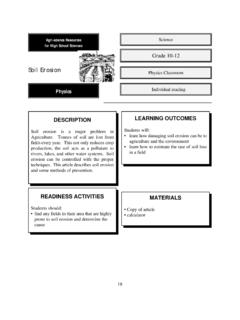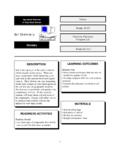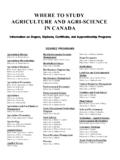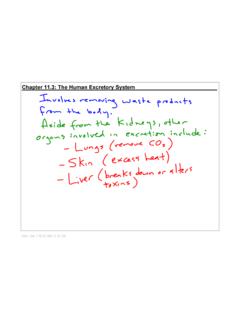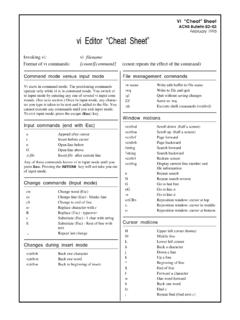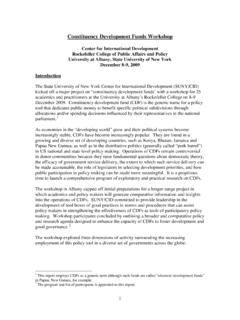Transcription of DESCRIPTION - Education, Early Learning and Culture
1 Agri-science Resources Science for High School Sciences Grade 10-12. Biogas Biology Lab Biology Teams of 2 or 3. DESCRIPTION Learning OUTCOMES. Biogas is a fuel which is produced from the Students will: breakdown of organic matter. Students will discover a valuable alternate energy have an opportunity to create their own resource biogas generators. At the same time, they will learn about the chemical reactions which occur during the breakdown of organic material. MATERIALS. a large plastic milk or water jug (about 4 L). one rubber stopper containing two holes that fits the jug opening READINESS ACTIVITIES one manometer tube (see illustration).
2 One pipette Students should: one burner tip that can be opened or have some knowledge of the types of closed (see illustration). energy sources which are currently being about 3 L of prepared slurry used. lab aprons, safety glasses, and rubber have a basic understanding of the biology gloves behind composting. matches felt-tip pens and tape or labels 1. Biogas Agri-science Resources for High School Sciences Biology Introduction A major concern for most people these days is the use and availability of energy. Canadians spend a large portion of their earnings on gas, propane and oil. These fossil fuels are being continuously used to a large extent.
3 Because these forms of energy are non-renewable, their availability will continue to decrease and costs will continue to go up. This has led to a search for new energy sources. Biogas One excellent source of energy is Biogas. This is produced when bacteria decompose organic material such as garbage and sewage, especially in the absence of oxygen. Biogas is a mixture of about 60 percent methane and 40 percent Carbon dioxide. Methane is the main component of natural gas. It is relatively clean burning, colorless, and odorless. This gas can be captured and burned for cooking and heating. This is already being done on a large scale in some countries of the world.
4 Farms that produce a lot of manure, such as hog and dairy farms, can use biogas generators to produce methane. Advantages Biogas energy offers many advantages. Biogas-powered electricity plants can be built quickly, simply, and for much less money per kilowatt than coal, oil, or nuclear power plants. Unlike these other current energy sources, Biogas is a renewable resource. Methane is going to be produced by decomposition whether it is used or not. Methane is also an important greenhouse gas and is a major contributor to the global warming problem. Biogas provides an excellent source of energy that is helpful to the environment. Finally, the residue from the burning of Biogas, called activated sludge, can be dried and used as fertilizer.
5 2. Agri-science Resources Biogas for High School Sciences Biology In this lab exercise, teams of 2 students will set up their own biogas generators. Figure 1. Completed biogas generator. The bent glass tube is called a manometer. It contains water which rises in the tube as gas is produced. Safety Precautions There are a few safety considerations to keep in mind during this experiment: - Be sure to use a plastic jug as the generator. The pressure build-up inside the generator may cause a glass bottle to explode. - Students should always wear aprons and safety goggles when testing for flammability. - When testing for flammability, be sure that the burner tip is pointed away from people or flammable materials.
6 - It is a good idea to wear gloves when handling the slurry and to wash your hands after handling it. 3. Agri-science Resources Biogas for High School Sciences Biology Procedure 1. Collect the slurry material and bring it to the lab. This is used to fuel the generator. It can be manure, household garbage, grass clippings or other green plant material, or dried manure from a garden supply store. 2. Build the generators and label them. Use figure 1 as a guide. The bent glass tube is called a manometer. Insert this into one of the stopper holes. It is used to indicate how much gas is being generated. It also allows for release of pressure if too much gas is produced.
7 The burner tip goes in the other hole. 3. Mix the fuel with water until it has the consistency of cream. This liquefied fuel is called a slurry. Put the slurry into the container. Fill it about three-quarters full. This will prevent foam from clogging the generator. The foam develops as gas is produced. Use funnels if possible. 4. Plug the generator with the stopper and store it in a warm place. Optimum temperatures are about 32-38 oC. Be sure the stopper fits the opening tightly. The only opening should be through the manometer. 5. Record the types and amounts of components in the slurry. Record the date the generator was created.
8 6. Check for gas production every day. Keep track of the date and any observations. When the water in the manometer has risen, gas has been produced. Test that gas for flammability by holding a match near the burner tip. BE VERY CAREFUL. The gas should not burn at first. Keep testing every day or two until methane is produced. 7. When methane production stops, discuss possible uses for the remaining sludge. Answer the following questions to help understand the lab. 4. Biogas Agri-science Resources for High School Sciences Biology Questions 1. Was the first gas produced flammable? What was the first gas? 2. The chemical formula for carbon dioxide is CO2.
9 Methane is CH4. Why is methane produced better in the absence of air (anaerobically)? 3. Did different materials produce methane at different rates? Which materials produced the most methane or produced methane first? 4. What could methane biogas be used for? 5. Methane biogas is a renewable resource. What does that mean? 6. What are some advantages of biogas as a fuel source? 7. What are some disadvantages of biogas as a fuel source? 8. Can you think of any places on Prince Edward Island where biogas could be used? Glossary of Terms decomposition the decay or breaking down of materials into smaller components fossil fuels a non-renewable resource such as gas which is created by the decomposition of organic material kilowatt a unit of electrical power equal to 1000 watts methane a light, colorless, odorless, highly inflammable gas organic material dead plant and animal tissues that originates from living sources such as plants, insects, and microbes.
10 Renewable resource resources that can replace themselves 5. Biogas Agri-science Resources for High School Sciences Biology NOTE: It could be helpful to create a sample biogas generator in advance. This could serve as a model and help to iron out any problems with the procedure. Answers to Questions 1. The first gas produced is carbon dioxide (CO2) which is not flammable. 2. Most bacteria grow more rapidly when they have a source of oxygen. When they run out of free oxygen in the air, some can obtain it from other compounds. Bacteria which use these compounds produce methane gas (CH4) as a waste product. 4. Methane can be used for anything that natural gas is used for.
